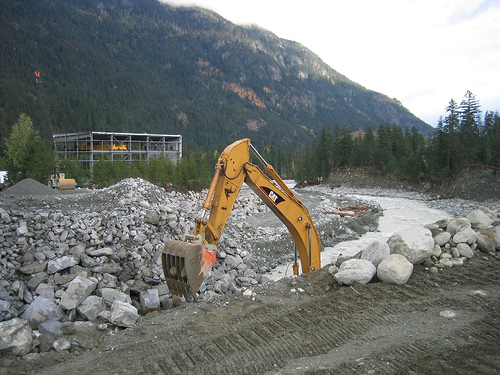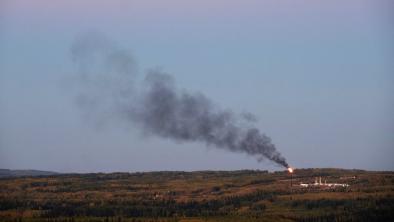Did they have to die?
Vancouver Province

Troubling questions arise about the night five people died when Rutherford Creek bridge was destroyed in a massive rainstorm
Seven-year-old Cole Burnette knows who his father is: He's the man who makes rainbows in the sky. The Burnette family has relied on Cole's youthful faith these past seven years. His father, Jamie Burnette, was killed when the Rutherford Creek Bridge washed away in 2003 during a heavy rainstorm.
The tragedy occurred 10 kilometres south of Pemberton, close to an area where a 49.5-megawatt run-of-river power project was being built by the Rutherford Creek Power company.
"Cole is the spitting image of his dad," says proud mom Katie Burnette-Dickie, who has remarried and returned to Ottawa to be close to Cole's grandparents.

Pemberton mayor Jason Sturdy says an investigation would be worthwhile.
"He's kind, sensitive, wonderful, a super athlete and Grade A student -- every trait his father had.
"He loves his dad. He knows his name is Jamie. When he was very little, Cole used to say "Good night, Daddy" to the picture on the fireplace mantel," Burnette-Dickie says tearfully.
Cole's grandpa, Barry Burnette, also finds the father-son resemblance striking.
"It's great to see him. . . . but I feel heartache for Jamie," he says.
Burnette-Dickie has moved on with her life. She owns a play-gym business and is raising a second son with a new husband.
"You learn to live with what you went through. There's no easy way to get over it. It's very difficult emotionally," she says.
But she still thinks about the night of Oct. 18, 2003, when Jamie, his brother Casey and their friend Ed Elliott were swept away after their SUV plunged into the raging creek.
Of the three, only Casey survived. The disaster claimed a total of five lives.
Those tragic days came flooding back last week when The Province called with new information that casts the events in a different light than they were initially explained.
The information comes via 800 pages of freedom-of-information documents, which were obtained from the provincial government by the Wilderness Committee and provided to The Province.
They raise troubling questions: Why did the bridge really
wash out that night? And was enough effort made to determine whether construction in the area was a contributing factor?
Failure to install drainage
The documents show that Peter Kiewit and Sons, a Fortune 500 contractor employed by Rutherford Power, failed to install the drainage ditches and culverts that were required in the area above the bridge.
During the months leading up to the disaster, B.C.'s Ministry of Forests told Kiewit several times to make the installations.
In 2005, after a two-year investigation, the company was fined $5,000 for breaching the Forest Road Regulations in five locations.
The company admitted to a "serious" breach of the regulations and spent $684,145 on road maintenance and damage repairs.
The ministry investigation and fines did not simply find fault after the fact.
Mere hours before the bridge washout on Oct. 17, 2003, ministry enforcement technician Stuart McDonald found so many contraventions of the Forest Practices Code that he shut the entire work-site down -- on the spot.
The site was not deemed fit for reopening for almost a month.
The Burnettes say the new information should be investigated to see if there was a connection between the company's violations and the bridge disaster.
Burnette-Dickie says she has "major concerns" about Kiewit's role.
"That the construction site was shut down one day before [the bridge washout] causes me a huge amount of concern. Kiewit did not abide by guidelines.
"If that contributed to the accident, I am speechless. This information is overwhelming. Something's been missed.
"I'm flabbergasted it didn't come to light until now. Obviously, we'd like answers," says Burnette-Dickie.
Kent Grisham, spokesman for Kiewit's North American operations, insists the company was not to blame in "any way, shape or form."
"It was a tragic fall period. These things were not connected. [The bridge failure] was not exacerbated or complicated by any run-of-river work that was done."
Ministry of Forests spokeswoman Vivian Thomas also says that Kiewit's "maintenance infractions" were not related to the bridge collapse.
Like an 'open-pit mine'
Kiewit's plans called for thousands of tonnes of soil excavation, alterations to slopes and the burying of a 2.4-metre high pipe -- called a penstock -- under a forest service road adjacent to Rutherford Creek.
Gwen Barlee, policy director at the Wilderness Committee, says the massive excavation changed the terrain above the river and affected drainage.
Barlee says there is no suggestion that the company was acting improperly with plans to excavate 600,000 tonnes of soil, "but one would think the construction affected the ability of water to flow safely through natural drainage structures."
"It also makes you wonder if the excavation added to the catastrophic mudslides and debris flow," she says.
Rutherford Valley rises steeply into the hills for 340 metres at Highway 99, but levels out farther along at the plant's water intake.
Rutherford Power awarded the construction contract to Kiewit, which began work in September 2002.
The centrepiece of the project was a penstock, which measured 2.4 metres high and ran for nine kilometres from intake to the power turbines at Highway 99.
To install it, a channel needed to be dug first, and then the penstock had to be covered over.
The company's biggest excavation, dubbed the Kiewit Cut, carved out thousands of tonnes of soil from the hillside.
Hardy Bartle, geotechnical engineer for the Ministry of Forests, says in the documents obtained by The Province that the scale of works at independent power projects is "more akin to an open-pit mine than a typical, or even exceptionally-large forestry project."
"The sheer size of the cut slopes and spoil sites appear to exceed the expectations of the Forest Practices Code," he says.
"On a per-kilometre basis, the quantity of earth work along the independent power projects is probably 10 times greater than a typical forestry road. A 10-kilometre power-project road is akin to 100 kilometres of forestry road under construction," he says.
Rutherford was rated for 49.5 megawatts, just under the 50 MW threshold that triggers a provincial environmental assessment.
The plant began producing enough annual electrical power for 7,000 homes in May 2004, and has since been sold to Innergex.
A mudslide in July
Government inspectors were concerned about Kiewit's contraventions of the Forest Practices Code for several months before the washout.
The inspectors noted a 30-metre-long by 2.5-metre-deep mudslide in July 2003, and the company was observed stockpiling gravel and cut materials at unapproved locations, as well as cutting trees outside of permitted areas.
Ministry officials were also concerned about a lack of culverts and ditches, and about slope stability and soil erosion.
In September 2003, enforcement technician Stuart McDonald was considering proceeding with charges related to violations of the Code.
A new name for a storm
The missing ditches and massive excavations weren't the only challenge facing the Rutherford Valley in mid-October of 2003.
A rainstorm originating in the tropics was on the way, which was to deliver almost as much water as the 1960 deluge that holds the record.
"The clouds didn't bode well," recalls Pemberton Mayor Jordan Sturdy, a berry farmer at the time. "I decided to move my pumphouse to higher ground."
Weather forecasters call a really big torrent a Pineapple Express, but they realized afterwards the expression was not suitable this time around.
The 2003 storm was later awarded the special designation "Tropical Punch."
The rains were so strong that Environment Canada's rain gauge in Pemberton was left under water.
The deluge peaked at 77 millimetres on Oct. 16 and 71 mms on Oct. 17 -- almost six inches over two days.
Those measurements were taken at the Whistler rain gauge, where rainfall is traditionally "a bit higher" than at Pemberton.
"It was bloody heavy rain for a couple of days. The Daisy Lake dam almost overtopped," says Environment Canada forecaster David Jones.
The stop-work order
On Oct. 17, enforcement technician Stuart McDonald arrived at Rutherford for a spot inspection.
As his truck climbed the steep hillside, he made hand-written notes, some of which concerned Forest Practices Code violations that he encountered along the way.
"Extensive erosion and landsliding" was found. There was a "significant amount of sediment being discharged into the creek" and at one point "no ditchline and no cross-drains."
"Thick mud" was duly noted, along with "no ditch between the road and the penstock." Further on, there was "no ditch and no culvert."
"There are major tension cracks in the fillslope," he says elsewhere.
McDonald gave up after five kilo-metres when the roadbed became too "washed out" to proceed.
He drove back to company headquarters and informed Kiewit site manager Brad Mytko that a stop-work order was being issued immediately. All heavy machinery was required to cease operation.
That was at 1 p.m.
Some 14 hours later, the Burnette brothers, Casey and Jamie, would be heading home to Pemberton after their late-night duties ended at Moe Joe's nightclub in Whistler
Shouted his brother's name
The Burnettes had moved to B.C. from Ontario to enjoy the outdoor life in Whistler.
Both volunteered as hockey coaches and Jamie, at 25 the oldest by three years, had been married to Katie just 28 days. Their young son Cole was barely old enough to recognize his father.
While the Burnettes served customers that night, the bridge was getting closer and closer to blowing.
Worried residents had called the RCMP in the afternoon because the normally small creek was swamped. Large trees were being swept along in it like toothpicks.
"The material coming down was incredible," says Pemberton Mayor Jordan Sturdy.
Sometime during the early hours of Oct. 18, authorities say "water flows of extreme velocity" eroded the Pemberton bank, eventually ripping away the entire bridge deck. Nothing was left at the crossing but a raging mass of water.
As the brothers got into Jamie's SUV, they were joined by their friend Ed Elliott, 26, for the 30-minute ride to Pemberton.
Jamie drove cautiously, mindful of the extreme weather. But the darkness enveloped the section where the bridge once stretched, and there was no time to react as the car slipped into the water. Casey said afterwards that the interior was filling before Ed had time to ask what was happening.
As the older brother, Jamie showed supreme coolness and judgment in the face of such a dire situation.
He told everyone to stay calm, wait until the car filled with water and take a deep breath. They were to escape via a rear passenger window, which had been broken by the debris, and then meet on the other side of the water.
It was a heart-wrenching moment for 22-year-old Casey; his brother's words have been seared in his memory since that day. Seated in the rear, Casey got out first and was tossed around like a rag in a washing machine.
He came to rest 500 metres downstream on a sandbar, still surrounded by water, but just out of reach of the even bigger Green River.
Expecting the others to arrive, he shouted his brother's name repeatedly until daylight came. Casey eventually swam out and was picked up by a passing motorist.
Two cars were approaching from the Pemberton side that night. Australian Darryl Stevenson, 31, and Michael Benoit, 29, originally from Nova Scotia, had been visiting friends.
Their Volvo was swept away and pinned under the collapsed bridge deck. When the car was located on Oct. 19, it had been flattened like a pancake by the force of the debris.
The third vehicle was an Isuzu Trooper, which had been reported stolen. The body of Pemberton resident Robert Michael Leibel, 35, was identified more than one year later when the car was discovered under a pile of mud near the bridge.
Further loss of life was prevented by Whistler cabbie Steve Dunn, who narrowly avoided disaster and then turned on his lights to warn away other drivers.
Bits of the Burnette's SUV turned up later, but no trace of Jamie Burnette or Ed Elliott has ever been found.
Ed's sister, Pam Elliott, spent weeks searching a huge debris pile filled with massive trees.
"There was so much mud and debris, we could have been right on top of them and not known it," says Elliott, still upset after all the time that has passed.
A 'Humpty-Dumpty scenario'
The boys' dad, Barry Burnette, who had already lost one of his three sons, has never felt quite the same.
Barry and the boys' mother, Ann, arrived at the scene the day following the disaster.
"We were the search party, plus some of Jamie's friends," Barry says from his Ontario home.
Official promises of a helicopter never materialized, although Burnette says choppers were ready to go. He believes police should have done a better job monitoring the bridge after they were warned by residents that the situation was looking dangerous.
"Nobody took responsibility. It was a Humpty-Dumpty scenario. There was no accountability. People passed on it," says Burnette.
"It was one big screwup. If everything had been done right, there's no question my boy would be alive. Who pays the price? The people who drowned. Unfortunately, none of this brings my son back," he says sadly.
Today, a shiny black marble bench lies a few short steps from the bridge, commemorating four of the victims. Robert Leibel was found too late to be included.
"We will never forget you," says the inscription.
The estimated $5,000 cost of the bench was reluctantly picked up by the B.C. government once Benoit's dad wrote a letter.
The collapsed bridge was a 23-metre long concrete and steel structure built in 1972 when the highway opened.
It has been replaced by a bridge three times as long. The new one is a 70-metre clear span that stretches from bank to bank, without requiring supports in the waterway.
The Rutherford Bridge and an adjacent rail span were the only bridges that failed along the Sea-to-Sky Highway during the storm.
A Kiewit connection?
On the morning of the fatal bridge failure, government conservation officer Chris Doyle wondered if "extensive erosion and land slides at Rutherford [Power]" were related to Kiewit's construction.
"The bridge has been blown out. This may be related to [Kiewit's] work. I will be starting a major investigation file," he says in an email written at 7:27 a.m. on Oct. 18, 2003.
Doyle wasn't the only one examining the possibility of a Kiewit connection that afternoon. Site manager Brad Mytko was on the case too.
He flew over the area and reported that all the company's recent construction works were "intact."
Mytko told ministry enforcement technician Stuart McDonald that "the washout was not caused by a works-induced slide."
Greg Hemphill, manager of the Sunshine Coast Forest District, refers to the subject in a Nov. 16, 2005, letter to Kiewit, but makes no comments.
"No submission was made indicating that the downstream impacts on Rutherford Creek were attributed to the [Kiewit] contravention," he says.
A 'classic construction disaster'
Kiewit was notified on Nov. 19 that the company's drainage practices would be investigated by the government.
But the investigation was narrowly focused on how Kiewit's works affected the forest service road, not whether the company's drainage shortcomings may have had anything to do with the bridge failure.
The ministry's investigation showed "fill failures along a significant length of road" and "no apparent drainage for a creek."
Government inspectors had 25 questions related to permitting, disposal of soil at unapproved sites and tension cracks on slopes.
In perhaps the most pointed comment, a ministry engineer called Kiewit's work a "classic construction disaster" where the "scale of the storm exceeded their protection measures."
The engineer, whose handwritten notes appear among the documents, refused to confirm his authorship when approached by The Province.
"This could affect my reputation. I could be sued," he said.
When the stop-work order was lifted on Nov. 12, 2003, Kiewit requested that access to the site be restricted until drainage was addressed. The company was "particularly concerned with mushroom pickers harvesting in proximity to job sites."
The Forest Road Regulations that Kiewit admitted to breaching included "ensuring the drainage system prevents water from being directed onto potentially unstable soil material."
Hemphill says "the gravity and magnitude of the contravention was significant."
"The contravention involved drainage related to deficiencies at a number of separate locations on the service road.
"The nature of deficiencies and the risks associated with not addressing them, should have been obvious to Kiewit," Hemphill says.
Kiewit says in a signed agreement that the company "recognizes that any contravention of the [Forest Road Regulation] is serious."
The company subsequently spent $394,540 on construction of the service road and $289,605 on repairs to storm damage.
The ministry recommended a $17,500 fine, near to the maximum $20,000 amount, but settled for $5,000. Documents indicate the ministry believed the matter was headed to court if a settlement was not reached.
The 2003 violations were not the only complaints about Kiewit's B.C. power projects. Complaints contained in another set of FOI documents by B.C. Environment Ministry employees in the same period include allegations a bridge was built illegally, and that substandard roads had caused numerous mud-slides.
Hope it 'never happens again'
MLA John Horgan, the NDP's energy critic, has called for an investigation into the bridge disaster.
"The question should have been answered whether construction practices were a factor in the loss of life," he says.
Pemberton mayor Jordan Sturdy says an investigation would "certainly be worthwhile" if it could find out "what happened and why."
"We can always learn from our experiences," he says.
Gwen Barlee of the Wilderness Committee, whose dogged research led to the documents being disclosed, is calling for a moratorium on run-of-river projects.
She says rules should be tightened, monitoring and enforcement increased and greater penalties handed out for violations.
Katie Burnette-Dickie, who has talked to a lawyer, wants to find the truth about the washout.
"In Cole's best interests, I can't ignore it," she says.
Pam Elliott, Ed's brother, says her family is "not interested in finding fault or engaging in lawsuits."
"All we want to see is that precautions are taken so this sort of thing doesn't happen again."


